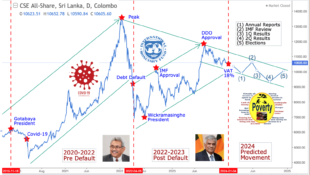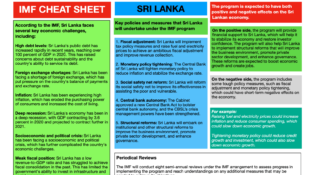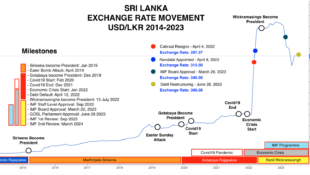Similarly, a temporary arrangement to finance the economic maneuver may be a cause of severe distortions and damages in the near future. The rosy picture of the economy in Pakistan in the first half of the first decade of 21st century has clearly indicated the unsustainable development by artificial improvements in macroeconomic indicators. In fact, improvement in macroeconomic indicators is not a sufficient justification of economic development. Without trickle down effects, the macroeconomic growth will not provide desirable results. There is a need to adopt a mechanism to transfer the effects of macroeconomic growth to the poor segment of society.
The impressive augmentation in the flow of foreign investment, growth in real GDP, tremendous improvement in stock market index and market capitalization, increase in foreign remittances, growth in export and enhancement in the foreign exchange reserves in the earlier five years of twenty first century have neither transformed in the socioeconomic improvement in the lives of common peoples nor sustainability in macroeconomic indicators has been achieved. During the era of macroeconomic growth, the economy had been facing the distress of higher inflation, severe incidence of poverty, further disparities in income inequalities, trade imbalances and fiscal deficits.
Unfortunately, unusual monetary expansion at present is another step in the same direction, which reflects the economic disaster in future. The unhistorical jump in the financing by the State Bank of Pakistan is a signal of disastrous economic situation in future. All evidences in the history of monetary expansion in Pakistan show that there is a direct and significant relation between inflation and monetary expansion. Obviously a time lag - which is always less than one year - is involved in the policy action and its consequences.
This is extremely important for all statesmen (and for those who love this country and the peoples of this country) that adverse effects of the policy measures can be shifted from one to another segment of the society depending on the nature of economic policy measures. It has always been a usual practice that burdens of the policy measures and unwise decisions have been shifted towards common peoples, and particularly to low income groups. Accelerated growth in indirect taxes, deficit financing by the central bank or external resources, subsidies to those public institutions which have financially damaged because of the corruption, criminal inefficiencies, ill-planning and mismanagement are those policy measures which ultimately transfer their burdens to the lower income groups. Tax exemption to the high income earners and wealth accumulators is also a major way of shifting economic burden to the common peoples. Who determines the direction of the burden of adverse consequences of economic policies; obviously, well worth and high income peoples who represent the common peoples in the parliament and establishment. How can they tax themselves? It is quit natural that they will always shift this burden to the lower income groups.
Several reasons can be identified for the poverty and economic problems of the common peoples in Pakistan. If it is assumed that their problems belong to their dishonesty, inordinate risk taking behavior, flawed planning, natural disastrous, and ill working habits, then it may be justified to mention that their economic problems are consequence and part of the nature. One can say that they deserve to live in the hard ways because of their sins. However, they should not be victimized because of others' sins. It is against the natural justice that low income peoples in a society are penalized because of the sins of their high income groups. If the problems of a common man are consequence of the ill planning, inefficiencies and corruption of the others who are in the driving seat, then the burden should not be transferred to those who are not responsible for these policies. The governing authorities will have to address this important aspect of natural justice on war footing basis.
To avoid from a painful revolution, the public representatives and leaders of the establishment have to make the decision to redirect the burden of adverse consequences of policies from lower and middle income groups to well worth segments of the economy. This is the only way to avoid from drastic and painful rebellion. If they do not agree to pay the taxes on their incomes and wealth, the painful rebellions will not demand for only taxes; they will restructure the distributional patterns of wealth and earning opportunities.
In policy formulation, it is extremely important to identify the differences between the objectives of short, medium and long term policies. In the present scenario, the objective of short term policy should be to avoid from any chaos and turmoil, while improvement in the macroeconomic indicators should be considered as a part of medium term planning. The long-term planning should be based on the development of those factors which can provide the bases and system's dynamics for a sustainable development. Unfortunately, the policy makers in Pakistan are emphasizing on long-terms objectives and policy indictors at the time when achieving the short-term goals are more important. The peoples like the reflection of economic development in their personal lives. The efforts to improve the visible economic and financial markets indicators may derail the objectivity of economic policies.
Here, it is also important that the weak decision making power and frequent changing in the decisions because of political pressures, black mailing, and ill intentions will create chaos and uncertainties in the economy. Economic decision making requires economic wisdom and political will power. Without political will power no rational decision is possible. In most of the cases ruling parties have to play a zero sum game in short term; though size of cake may be enhanced in the longer term. In such games, patterns of the vote banks of political parties may be changed. In most of the cases, economic development has to pass through a painful and time consuming process. The benefits of political parties are less important than benefits of the country. If defeat of a political party leads the winning of Pakistan, the option is not bad. Every statesman should realize it.
ECONOMIC PLANNING IN PAKISTAN Medium-term planning is a most effective component of economic strategies in present regime of globalization which is mainly based on supply side economic policies. Economic planning determines the ultimate business competitiveness and provides the infrastructure for sustainable growth.
1 Economic Planning in Earlier Stage: Indian Planning Commission was formed in 1950 and Shanmukham Chetty was appointed as Head of Planning and Finance Ministries by Nehru reflected that economy is important than ideology in India. Since then head of planning was always a world renowned economist. Its last head was Montek Singh Ahluwalia- an internationally renowned economist and professor of economics in top US universities.
The economy of Pakistan at its earlier stage led by Liaqat Ali Khan, I.I. Chundrigar, Ghulam Muhammad (Secretary Finance) and Zahid Hussain (Governor State Bank of Pakistan). Success of this team was remarkable and international community surprised on the fast development and growth in Pakistan.
-- First two five years plans of India were scrapped, and according to Indian policy makers it was due to non-cooperation from Pakistan, when India devalued its currency, faced draught, and wanted to free trade with Pakistan.
-- 'Hindu Rate of Growth' by Indian economist Raj Krishnahigh; observing high growth rates in non-Hindu Asian countries; This term, popularized by Robert McNamara, referred to the supposed Hindu outlook of contentedness.
2. Policies Since 1970s
-- Since early 1970s, Pakistan has been facing failure of economic planning, since earlier 1990s declining in GDP growth rate, and since 2001 the lowest ranking in per capita income in the region.
-- Planning in Pakistan was based on the nexus of foreign influence, ideology and Feudalism
-- Pakistan was compelled to adopt a 'Balance growth strategy'
-- Seven regimes of Planning in Pakistan: (i) Conceptualization; (ii) Foreign Influence; (iii) Adhocism; (iv: Revival of Planning; (v) Construction of Social Accounting Matrix and Macro Econometric Models by Planning Commission; (vi) PCI and PCII culture, and (vii) Ineffective organ .
-- These 'sins' are: Fascination with numbers; Love for excessive controls; Preoccupation with investment levels; Addiction to development fashions; Divorce between planning and implementation; [Economic] growth without justice; and Neglect of human resources.
3 Survival vs. Revival
-- Theme of the revival strategy is based on the slogan: "Revival of Economy through Straight Path of Infrastructure Development". In the journey of revival through the straight path we cannot ignore the survival of economy. So, our strategy is divided into two parts: first belong to the survival and second part covers the revival mechanism.
-- Demand Management (Fiscal and monetary) policies are applied for the survival of economy, while medium and long term supply side policies are recommended for the revival of economy.
-- In survival strategy, our main target is to control over poverty by reducing inflation and unemployment. To control over inflation, we suggested two measures: first belong to fiscal policy and the other belongs to monetary policy.
DEMAND MANAGEMENT STRATEGY
1 FISCAL POLICY
-- We recommend an expansionary fiscal policy; however we are not in favor of excess public borrowing and use of cash balance.
-- Before describing the basis of suggested measures, it seems necessary to describe the present structure of taxation policies in Pakistan. It is unfortunate that tax rates in Pakistan are considered as major hurdle in investment. Tax as percentage of gross profit is 57 percent in Pakistan, while it is 43 percent in India, 11 percent in Malaysia, 21 percent in USA, and 50 percent in Bangladesh. The average tax rate on corporate sector in Pakistan is 41 %; it is 36 % in India, 28 % in Malaysia, and 35 % in USA.
-- It is important to note that tax system in Pakistan emphasizes on indirect taxes and surcharges. The traditional approaches for financing the deficit and mobilization of resources through heavy indirect taxes have been damaging the economy of Pakistan. This approach leads the poverty and inflation.
-- The share of indirect taxes in central government revenue is around 70 percent in Pakistan, 53 percent in India, 54 percent in Malaysia, 62 percent in UK and 50 percent in USA. The lower share of direct taxes in Pakistan is because of exemptions and less efforts for tax collections from agriculture, services, real estates and retail trading activities. This situation leads to dependency on indirect taxes. The indirect taxes hampered the industry in multiple ways: they increase the cost of production and reduce the demand of manufacturing goods. In this way, they damage the industrial competitiveness and induce inflation in the economy. FPCCI has recommended the shifting of dependency from indirect to direct taxes.
-- To increase its revenue government should encourage revenue enhancement through direct taxation on equity and egalitarian basis. Tax should be paid according to the magnitude of earning regardless the source of earning.
-- We strongly suggested a significant reduction in GST. It will reduce the rate of inflation, provide relief to general public, accelerate economic activities and improve economic efficiencies. This is the pivotal point of our taxation policy.
-- This step will improve the buying power of general public, enhance the magnitude of economic activities and will help the industry in revival process. The reduction in the rate of sales tax will enlarge the size of consumer markets and government earnings will definitely increase.
-- FBR sources have been indicating that the effective tax rate of GST is less than 5 percent, which indicate that 71 percent of total collection of sales tax is paid back in account of input adjustment and refund claims. We suggest that this culture of refunds should be abolished and government should collect GST at the rate of 5 percent. It will transfer the benefits to the end consumers, and lead the decline in poverty and inflation.
2 MONETARY POLICY:
-- The increase in money supply by use of cash balance to finance fiscal deficit is directly linked with the inflation in country and pressurizes the value of domestic currency. In past it was a major cause of inflation and depreciation of Pakistani rupee in international market.
-- We strongly reject the budgetary financing through banking system; it creates several problems for the industry. Liquidity crunch in financial markets, higher rate of interest and higher inflation are the ultimate outcomes of the use of cash balance by the government to finance its fiscal deficit. We believe that revenue generation by the federal government through bank borrowing is an indirect tax on the industry and general public. This tax is paid by the public and industry in the form of higher spending due to inflation created by the use of cash balance by the government.
-- In last 5 years the trend of financing was changed but it was mere a shift from the State Bank of Pakistan to the commercial banks.
-- Borrowing from commercial banks to finance the fiscal deficit has become an easy and common option in Pakistan during the last five years. Commercial banks are encouraged to utilize public deposits for deficit financing of federal government at a higher rate of interest. In this way they avoid from risk management and evaluating the business plans and feasibility reports for investment activities in private sector. The public money and surplus savings which should be utilized for investment in the country are used for financing public sector activities. It leads the unusual and irrational higher in the interest rate and shortage of investable funds in capital market. The higher interest cost payable by the government to banking industry is ultimately paid by the public through higher taxes. The multiple adverse effects of this practice are hampering the economy.
-- We suggest that government should avoid from bank borrowing and use of cash balance. The parliament has passed 'Fiscal Responsibility and Debt Limitation Act' in 2005. This act should be implemented in its true spirit, and government, opposition parties and judiciary should be responsible for implementation of this act. It will create financial discipline in the economy. Several negative externalities of external borrowing create irritants in the economy. They shift the burden of repayment to the forthcoming generations. So these options should also be avoided.
3. PRIVATIZATION AND FINANCING THE DEFICIT
-- To finance the fiscal deficit, we suggest the use of proceeds from privatization of public sector commercial entities. This fund should be utilized to finance those development projects which are required for the accelerated growth of private sector investment including FDI. According to a conservative estimate, government can earn 20 billion dollars through privatization of those 32 public sector entities which have been approved for the privatization by the federal cabinet. (Out of these 20 billion worth projects, we suggested privatization of 9 institutions from financial and energy sector. It will generate 2.02 billion dollars).
-- We are not in favor to create unemployment or any compromise on the economic, social and community services. As we know that Pakistan spends only 4 percent of public expenditures in account of salaries and wages, while this ratio is 8 percent in India, and 25 percent in Bangladesh. Unfortunately, we have to pay 37 percent of our public expenditures in debt servicing; this share is 13 percent in India, 17 percent in Bangladesh and 13 percent in Sri Lanka. About 65 percent of our current expenditures are consumed for interest payment and defense services. How can the remaining 35 percent can fulfill the requirement of health, education, administration, law and order, economic, social and community services of an economy of more than 180 million inhabitants?. These statistics show our limitations and causes of the problems of lower growth, in-competitiveness, unemployment and poverty in the country.
SUPPLY SIDE POLICIES
-- It has been mentioned that proposed fiscal and monetary policies provide a survival strategy, however, the stagnancy of traditional fiscal policies in Pakistan has failed to revive the economy and we do not have fiscal space for badly needed developing projects. The badly deteriorated physical infrastructure in Pakistan does not support the economic progress and industrialization. To accelerate investment and industrialization in the country, we have to develop physical infrastructure of ports, means of transportation, energy and communications.
-- The history of public finance in Pakistan indicates the misuse of funds for the development of politically-motivated projects: to offset the losses of commercial institutions in the public sector, to create inflated employment opportunities, to subsidise public services and to finance unnecessary populist projects. The cost of these bad decisions is ultimately paid by the middle and lower middle class peoples in the form of indirect taxes.
-- At present, much fiscal space and resources are not available in public sector to develop the country. Foreign assistance and external debt options are no longer available in present global scenario. So, revival strategy will be based on private sector investment. It is the only feasible option to develop the badly deteriorated infrastructure in Pakistan. Greenfield investment and capitalizing the savings of expatriate Pakistanis are also included in this program.
-- Here it is important to note that the miracle growth of Indian economy after 1990 depends largely on foreign investment, while this investment is not from foreign funds' managers and MNCs. More than 60 per cent inflow of FDI in India belongs to expatriate Indians. Major part of FDI in India belongs to Singapore and Mauritius (not from USA, UK or developed countries). The biggest part of this investment in India belongs to expatriate Indians who live abroad. We should also encourage those Pakistanis to contribute in the economic development of Pakistan by inducing investment in the national rebuilding projects including construction, steel industry, energy sector, and financial services.
-- In past, Development Finance Institutions (DFIs) have been playing an important role in the development of infrastructure in Pakistan. NDFC, PICIC, PIDC, IDB and BEL are included in these institutions. Now, the role of DFIs in the economic development is almost negligible, while monetary policy and banking system do not support the mega projects in Pakistan. In its monetary policy, Pakistan has been adopting a quantitative easing to finance the budget deficit.
-- At initial stage government has to develop the basic infrastructure to boost the private investment. Now, we are lacking the development finance institutions (DFIs). In the absence of these institutions we suggested a 'New Development Initiative program'. It will not be a part of PSDP and will be govern by a separate board of governors including representation of stakeholders from private sector.
-- For successful launching of supply side policies, changes in economic and social policies are required. Financial openness, economic freedom, trade liberalization, and changes in the social and political policies are required to attract foreign investment for long-term projects. Global and regional integration, new public management, the lean government are also the associated policy measure for economic liberalization.
1. GREENFIELD INVESTMENT
-- There is no doubt that Gwadar-Kashgar railway link, Motorways and linked highways, construction of big dams and energy producing and transmitting networks, and expansion in ports capacity are required at the initial stage of accelerated development process.
-- These projects will lead the enhanced activities in construction, energy, steel, mining, transport and financial sector. Vested interests of various groups at national and international levels may be involved in this fast developing process. We suggest avoiding from politicizing these economic ventures. It is possible only when we create transparency and liberalization for all stakeholders on competitive basis without discrimination.
-- Though, government has introduced Greenfield Investment scheme for such developmental projects, but necessary legal framework and administrative measures have not been taken to implement those investment policies till now. It was observed that major irritants in the systems are not based on economic policies; these are based on administrative measures and procedural requirements.
-- Greenfield investment policy requires the constitutional amendments. We will have to highlight and then amend all those administrative obstacles which are discouraging investment. Those obstacles may be at local, provincial or federal government levels.
2. 'GWADAR-LED GROWTH MODEL'
-- This model covers three areas: (1) Fast track development of Gwader Port; (2) Gwadar Free Economic Zone; and (3) Gwadar-Kashgar Motorway and Rail road. Though government has already initiated this program, however, in the light of past experience and obstacles we suggested some additional measures including creation of an infrastructure development fund.
-- The development of Gwadar free port is one of the major recommended strategies to develop the physical infrastructure and revolutionize the economic growth of Pakistan. The development of Gwadar free port is in fact, a multi dimensional strategy which covers the international linkages in trade and investment. The strategy follows an 'Urban-led Growth Model' which has been tested and implemented in Singapore, Dubai and Bangkok and to some extent in Indian economy, where development planners have focussed on fast track development of 5 major Indian cities.
-- To consider the development of such mega projects through fiscal resources in public sector is mere a great misunderstanding. In past, fiscal policy has always failed to support the necessary investment in the development of infrastructure. Lack of transparency, insufficient tax collection, uneven burden of taxes, the people's mistrust of policy makers and bad governance are the key factors which have contributed to the failure of fiscal policy in Pakistan.
CONCLUSION
-- Before submission of the present strategy for the 'Revival of Economy', we have submitted a long-term strategic plan for economic development of Pakistan (FPCCI Economic Vision 2025). Some constitutional and administrative measures have also to be taken by the government for successful implementation of revival strategy. These included: (1) Preparation of a Legal framework for 'Greenfield Investment Plan'; (2) Improving in 'Law and Order' situation; and (3) Solving the Energy Crisis (including inventory management and uninterrupted supply of oil products, uninterrupted supply of electricity and gas on competitive prices).
-- The above-mentioned (2) and (3) are under active consideration of the present governments and we hope that government will successfully tackle these two issues during the year.
-- For above (1) FPCCI have preparing a separate report and before issuance a comprehensive report to highlight the required amendments in the laws, rules and regulations to frictionless implementation of greenfield investment plan and inducing FDI, we organize a round table conference with all stakeholders.
-- To support the inflow of foreign investment, support from the legal and institutional establishment is required. Political governance has an important role to play in the success of this policy. Foreign investors may also be interested in Pakistan because surplus savings and investable funds are available in various economies in the present global conditions. The decline in the rates of return in industrialised countries and much lower interest rates provide comparative advantages to invest in Pakistan. To invest in Pakistan is a rational decision for fund managers, investment advisors and investment companies.
-- The significant decline in inflation because of lower rate of GST and lesser borrowing from central bank will improve the socioeconomic environment in the country. Conservatively speaking, at least 500000 new job opportunities will be created because of 7 percent growth in GDP.
-- After enhancement in economic activities including infrastructure development, fast track privatization program and lower rate of GST, further acceleration in growth is expected.
Copyright Business Recorder, 2015
http://www.brecorder.com/supplements/88/1155382/
 would enable you to enjoy an array of other services such as Member Rankings, User Groups, Own Posts & Profile, Exclusive Research, Live Chat Box etc..
would enable you to enjoy an array of other services such as Member Rankings, User Groups, Own Posts & Profile, Exclusive Research, Live Chat Box etc.. 
 Home
Home

















